Uji Aktivitas Ekstrak Karang Lunak Sarcophyton sp Terhadap Staphylococcus aureus
Abstract
Sarcophyton sp. is one kind of soft corals are today widely studied bioactive content as raw material for making drugs. Some research indicates that extracts Sarcophyton sp. Has many contain terpene compounds that function as antimicrobial, anticancer, antitumor, and anti-inflammantori. Research on Testing Activities Extract Coral Sarcophyton sp against Staphylococcus aureus has been done with the aim to determine the antimicrobial activity of extracts Soft Coral Sarcophyton sp against Staphylococcus aureus. Research conducted by the diffusion method, using iron cylinder diameter in the outer diameter of 6 mm and 8 mm, with an incubation period of 24 hours at 37° C. There are three test concentration of 5%, 10%, and 15% w/v, with the results of each inhibition zone average diameter: 8.91 mm, 9.92 mm and 11.18 mm. In this study a comparison is Tetracycline HCL is used as a positive control with a diameter of inhibition zone produced is 24.18 mm and Na.CMC 1% as a negative control. The results showed that the Soft Coral Sarcophyton sp extract can inhibit the growth of Staphylococcus aureus in consentration 5%, 10%, and 15% w / v. This study found that the higher concentration of the extract Soft Coral Sarcophyton sp has the higher of inhibitory power. The amount of concentration is directly proportional to the diameter of inhibition zone obtained.
Downloads
References
Badria FA, Guirguis AN, Perovic S, Steffen R, Muller WEG, dan Schroder HC, 1998, Sarcophytolide: a new neuroprotective compound from Soft coral Sarcophyton glaucum, Toxicology, 131(3): 133-143.
Branen AL, Davidson PJ., 1993, Antimicrobial in Foods, New York: Marcel Dekker.
Coll JC, Sammarco PW., 1983, Terpenoid toxins of soft corals (Cnidaria, Octocorallia) their nature, toxicity and ecological significance, Toxicol Suppl 41(3): 69-72.
Harper MK, Bugni TS, Copp BR, James JD, Lindsay BS, Richardson AD, Schnabel PC, Tasdemir D, Van Wagoner FM, Verbitski SM, Ireland dan CM, 2001, Introduction to The Chemical Ecology of Marine Natural Products, Di dalam: McClintock JB, Baker BJ, editor, Marine Chemical Ecology, USA: CRC Press.
Hardiningtyas, S.D, 2009, Aktivitas antibakteri ekstrak karang lunak Sarcophyton sp yang difragmentasi dan tidak difragmentasi di perairan Pulau Pramuka, Kepulauan Seribu, Skripsi, Bogor: Departemen Teknologi Hasil Perairan, Fakultas Perikanan dan Ilmu Kelautan, Institut Pertanian Bogor.
Jawetz E, Melnick J, Adelberg E., 2005, Mikrobiologi Kedokteran, Medical Microbiology oleh Nugroho E, Maulany RF, Jakarta: EGC.
Jawet E, 1998, Obat-obat Kemoteuratika, Basic and Clinical Pharmacology oleh Katzung BG, editor. Staf Dosen Farmakologi Fakultas Kedokteran UNSRI, Jakarta: ECG.
Khatab RMA, Ali AE, El-Nomary B, Temraz TA, 2008, Screening For Antibacterial And Antifungal Activities Some Selected Marine Organisms Of The Suez Canal And Red Sea, Egypt J Exp Biol (Zool), 4(8): 223-228.
Nybakken, J. W, 2000, Biologi Laut, Suatu Pendekatan Ekologi.
Diterjemahkan oleh H. M. Eidman, Koesoebiono, D.G. Bengen, M. Hutomo dan S. Sukarjo. Jakarta: PT. Gramedia.
Pelczar MJ, Chan ECS, 2005, Dasar-Dasar Mikrobiologi 2, Elements of Microbiology oleh Hadioetomo RS, Imas T, Tjitrosomo SS, Angka SL, Jakarta: UI Press.
Radhika P, 2006, Chemical Constituens And Biological Activities Of The Soft Coral Of Genus Cladlella: A Review, Biochemical Systematich and Ecological, 34: 781-789.
Sawant S, Youssef D, Mayer A, Sylvester P, Wall V, Arant M, El-Sayed K, 2006, Anticancer And Anti-Inflamantory Sulphur-Containing Semisynthetic Derivatives Of Sarcophine, Chem, Pharm. Bull, 54(8): 1119-1123.
Schlegel HG, Schmidt K, 1994, Mikrobiologi Umum, Baskara T, Yogyakarta: Gajah Mada University Press.
USDA, 2003, USDA Database for the Flavonoid Content of Selected Foods. U.S.Department of Agriculture, Marryland, USA.
Authors who publish with this journal agree to the following terms:
1) Authors retain copyright and grant the journal right of first publication with the work simultaneously licensed under a Creative Commons Attribution License that allows others to share the work with an acknowledgement of the work's authorship and initial publication in this journal.
2) Authors are able to enter into separate, additional contractual arrangements for the non-exclusive distribution of the journal's published version of the work (e.g., post it to an institutional repository or publish it in a book), with an acknowledgement of its initial publication in this journal.
3)Authors are permitted and encouraged to post their work online (e.g., in institutional repositories or on their website) prior to and during the submission process, as it can lead to productive exchanges, as well as earlier and greater citation of published work (See The Effect of Open Access).


